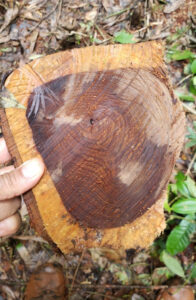WHAT MAKES US DIFFERENT
Lesser-Known Timber Species
 From the colonial period, Central America’s tropical forests have been heavily exploited. A small fraction of species has been disproportionately extracted. Among these, in our region, are big-leaf or genuine mahogany and Honduran rosewood, both listed by CITES as threatened by over-exploitation. These species are sometimes referred to as noble hardwoods due to their workability, durability, natural beauty and even tonal properties lending them to high-end uses such as musical instruments, boat building, and fine furniture. These iconic species have been over-exploited to the point of commercial exhaustion across much of their natural range. According to a CITES paper, the rosewood genus is fragmented and many species populations are in decline mainly due to human disturbances. The vast majority of Izabal’s forests have already been “cream skimmed” for their precious timbers. Oxford researchers describe how the process ultimately leads to degradation:
From the colonial period, Central America’s tropical forests have been heavily exploited. A small fraction of species has been disproportionately extracted. Among these, in our region, are big-leaf or genuine mahogany and Honduran rosewood, both listed by CITES as threatened by over-exploitation. These species are sometimes referred to as noble hardwoods due to their workability, durability, natural beauty and even tonal properties lending them to high-end uses such as musical instruments, boat building, and fine furniture. These iconic species have been over-exploited to the point of commercial exhaustion across much of their natural range. According to a CITES paper, the rosewood genus is fragmented and many species populations are in decline mainly due to human disturbances. The vast majority of Izabal’s forests have already been “cream skimmed” for their precious timbers. Oxford researchers describe how the process ultimately leads to degradation:
The creaming of forest is an insidious, wasteful and destructive process. It removes the best species, usually reducing their capability to regenerate and compete with other species; it may also reduce the genetic quality of these species because there is often selection against the best individuals in the population. Many high value tropical species are of medium density and strength; they are neither the very fast growing, low density light demanders nor the very high density, slow growing shade tolerant “ironwoods”. They are, therefore, often moderately light demanding and regenerate best under some, but not too much shade.” ¹
A report by the WWF summarizes the benefits of LKTS succinctly:
- LKTS can frequently substitute for better-known species in terms of function, performance and appearance. They are generally less expensive because they are abundant and underutilized. An example is the use of tamarindo or selillón, referred to as ironwoods, instead of ipe.
- The diversity of LKTS means a wide range of colors and textures that can offer new design opportunities to architects and designers. Some of our woods offer brilliant red tones, such as sangre de dragon (dragon’s blood) and redheart (Chakte kok), nazareno, a vibrant purple tone, and aceituno, a pale whitish hue.
- Most importantly, adopting LKTS helps alleviate pressure on over-exploited timber species and strengthens the feasibility of sustainable forest management. By widening the spectrum of species, woods like cocobolo, Honduran rosewood and mahogany, can slowly regenerate.
IWC’s focus on LKTS is consistent with the framework of various other public and nonprofit initiatives. The World Wildlife Federation (WWF) has worked to develop awareness of the commercial importance of LKTS’ role in forest protection. WWF’s Global Forest and Trade Network has funded studies, trade platforms and campaigns to promote the use of species not commonly known on international markets but nonetheless highly prospective from a variety of uses. WWF published a practical guide to 50 lesser-known species with a variety of uses and the better-known species they can substitute. The European Sustainable Tropical Timber Coalition has assembled a useful clearinghouse of resources on LKTS across the tropics. And FSC Denmark manages a practical guide on some of the world’s 50,000 lesser known timber species for timber buyers interested in supporting sustainable forest management.
Developing markets for LKTS is an enormous challenge. In some cases, the species are not widely distributed and therefore less attractive to large industrial wood processors who rely on consistent volumes. In other cases, the species present greater challenges in milling and drying. Even though technical issues are often surmountable with appropriate technology and handling, the species may develop undeserved reputations as problematic and are shunned by buyers.
¹ Smith et al. “‘PROSPECT’ for the Improved Use of Tropical Timbers.” Oxford Forestry Institute. 1994.

